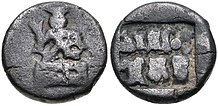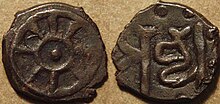Ahichchhatra
 One of the Shiva temple ruins at Ahichhatra . | |
| Location | Uttar Pradesh, India |
|---|---|
| Coordinates | 28°22′16″N 79°08′10″E / 28.371°N 79.136°E |
| Type | Temples |
| History | |
| Founded | c. 1500 BCE |
| Cultures | Ochre Coloured Pottery culture, Black and red ware, Painted Grey Ware culture, Gupta Empire |

Ahichchhatra or Ahikhet (Sanskrit: अहिच्छत्र, IAST: Ahicchatra) or Ahikshetra (Sanskrit: अहिक्षेत्र, IAST: Ahikṣetra), near the modern Ramnagar village in Aonla tehsil, Bareilly district in Uttar Pradesh, India, was the ancient capital of Northern Panchala, a northern Indian kingdom mentioned in the Mahabharata.[2]
Most of the city was half a mile north-east of the modern village, with a large mound, popularly called the fort, two miles west of this. Several significant finds of sculpture, in both stone and (especially) terracotta of the early centuries CE, have been made at the site and are now in various museums. Excavations have uncovered nine strata, the lowest from before the 3rd century BCE and the latest from the 11th century CE.[3]
The city appears to have reached its height during the period of the Gupta Empire. The region lacks sources of good stone and was a centre for making Indian pottery at various periods, and in the early CE the temples were decorated with unusually large terracotta relief panels and sculptures, many of very high quality.[4]
Names
[edit]The word Ahi means snake or Naga in Sanskrit. Nagas were a group of ancient people who worshiped serpents. The word khsetra means region in Sanskrit. This implies that Ahi-kshetra was a region of Nagas.
Vividha Tirtha Kalpa, composed by Jain Acharya Jinaprabha Suri in the 14th century CE, mentions Samkhyāvatǐ as the earlier name of Ahichchhatra and describes two Jain temples dedicated to Parshvanatha in the area. Ahikshetra is mentioned as Shankavai Samkhyavati in Vividhatirthakalpa.[5]
History
[edit]According to Jain Tradition, the history of Ahichchhatra traditionally starts from the period of 1st Tirthankara Rishabhanatha. It was visited by all 24 Tirthankaras. Ahichchhatra is believed to be the place where Parshvanatha, the 23rd Tirthankar of Jainism, attained Kevala Jnana (omniscience).[6]
Its history reaches back to late Vedic times, at which time it was capital of the Panchala kingdom. The name is written Ahikshetras as well as Ahi-chhatra, but the local legend of Adi Raja and the Naga, who formed a canopy over his head, when asleep, shows that the later is the correct form. The fort is said to have been built by Adi Raja, an Ahir[7] whose future elevation sovereignty was foretold by Drona, when he found him sleeping under the guardianship of a serpent with expended hood. The fort is also called Adikot.[8]

Obv Indra seated facing on pedestal, holding bifurcated object.
Rev. Idramitrasa in Brahmi, Panchala symbols.
The last independent ruler of Ahichatra was Achyuta Naga, who was defeated by Samudragupta, after which Panchala was annexed into the Gupta Empire.[9] The coins of Achyuta found from Ahichatra have a wheel of eight spokes on the reverse and the legend Achyu on the obverse.[10]
Archaeology
[edit]The site was briefly explored by Sir Alexander Cunningham in 1871, and then excavated by the ASI from 1940 for "about five years".[3] The excavations found brick fortifications and continuity of occupation from a period before 600 BCE to 1100 CE.[11] During the first excavations in 1940–44, the Painted Gray Ware pottery were found at the earliest level. Ruins of this city could be identified from the remote sensing imagery of IRS (Indian Remote Sensing) satellites. The ruins reveal that the city had a triangular shape. Recent excavations in Ahichchhatra showed it was first inhabited by the middle of the second millennium BC with Ochre Coloured Pottery culture people, followed by Black and Red Ware culture. Around 1000 BC, it reached at least 40 hectares of area, making it one of the largest Painted Grey Ware culture sites. Evidence of construction of early fortifications were discovered around 1000 BC indicating first urban development.[12][13] Near Ahichchhatra, 2 km to its west there is a big pond which is said to trace its ancestry to the time of Mahabharata. The pond, located in the village of Jagannathpur is said to have been made by the pandavas at the time of their forest dwelling (vanvas).
In the early Gupta period a section of the city set aside for pottery contained very large firing pits, some 10 or 12 feet deep.[14]
Jain tradition
[edit]


Ahichchhatra is believed to be the place where Parshvanatha, the 23rd Tirthankar of Jainism, attained Kevala Jnana (omniscience). The temples in Ahichchhatra are built to commemorate Parshvanatha attaining Kēvalajñāna kalyāṇaka.[15] This temple is dedicated to Parshvanatha and is major Jain pilgrimage center.[16][17] According to Uttar Pradesh Tourism, Ahichhatra Jain Temple witnessed over 4 lakh visitors in 2017.[18] Ahichhatra Jain Mela is the primary festival of this temple and is organized annually in March.[17]
Means of approach
[edit]From the Revati Bahoda Khera Station on Chandosi – Bareilly Line, vehicle of Kshetra and other vehicles are available. Road: - Buses are available from Delhi, Meerut, Aligarh, Lucknow, Kasganj & Badaun. Train: - Trains are available from Delhi, Bareilly, Agra, Moradabad, Aligarh to Revati Bahoda Khera Station and vehicles are all time available for Ramnagar from Revati Bahoda Khera Station. Airport: - Delhi 250 km
Nearby Places
[edit]Nainital – 180 km Hastinapur Atishaya Kshetra – 200 km Kampilji Atishaya Kshetra – 180 km Manglayatan (Aligarh) – 180 km Bareilly – 55 km
Sculpture from Ahichchhatra
[edit]-
23rd Tirthankara Parshvanatha sculpture excavated from Ahichchhatra, 7th century BCE
-
Stone Buddha, c. 1st Century CE, Kushan Period
-
Sandstone Shiva, 3rd century
-
Terracotta architectural panel with Goddess, Gupta period, 5th century
-
Gupta period terracotta Yamuna, pair to the Ganga above
Notes
[edit]- ^ Harle, James C. (January 1994). The Art and Architecture of the Indian Subcontinent. Yale University Press. p. 117. ISBN 978-0-300-06217-5.
- ^ Malik, Dr Malti (2016). History of India. New Saraswati House India Pvt Ltd. pp. 51–54. ISBN 978-81-7335-498-4.
- ^ a b Kala, p. xv
- ^ Majumdar, 429-430
- ^ Subodh Kapoor 2002, p. 16.
- ^ "Brochure Ahicchatra" (PDF). Archived from the original (PDF) on 25 May 2022. Retrieved 20 April 2022.
- ^ Kapoor, Subodh (2002). Encyclopaedia of Ancient Indian Geography. Cosmo Publications. ISBN 978-81-7755-298-0.
- ^ Subodh Kapoor 2002, pp. 17–19.
- ^ Raychaudhuri, H.C. (1972). Political History of Ancient India, Calcutta: University of Calcutta, p.473
- ^ Lahiri, B. (1974). Indigenous States of Northern India (Circa 200 B.C. to 320 A.D.) , Calcutta: University of Calcutta, p.182
- ^ Lahiri, Bela (1972). Indigenous States of Northern India (Circa 200 B.C. to 320 A.D.), Calcutta: University of Calcutta, pp.170-88
- ^ "What Lies Beneath".
- ^ http://www.educationtimes.com/article/290/20130917201309171524062507304cdb3/What-Lies-Beneath.html What lies Beneath, B. R. Mani 2013
- ^ Majumdar, 430
- ^ UP tourism & Ahicchatra, p. 2.
- ^ Jain 2008, p. 64.
- ^ a b UP tourism & Uttar Pradesh: A to Z, p. 31.
- ^ UP tourism & Year-wise Tourist Statistics.
References
[edit]- Kala, Satish Chandra, Terracottas in the Allahabad Museum, p. xv, Abhinav Publications, 1980, ISBN 0391022342, 9780391022348, google books
- Kapoor, Subodh, ed. (2002), Encyclopaedia of Ancient Indian Geography, vol. 1, Cosmo Publications, ISBN 81-7755-298-8
- Jain, Lakshmi (2008). Dropout of Girl-child in Schools. Northern Book Centre. ISBN 9788172112448.
- Majumdar, Ramesh Chandra, Vakataka – Gupta Age Circa 200-550 A.D., 1986, Motilal Banarsidass Publ., ISBN 8120800265, 9788120800267, google books
- Uttar Pradesh Tourism
- Uttar Pradesh Tourism. "Uttar Pradesh: A to Z" (PDF). Uttar Pradesh Tourism.
- Uttar Pradesh Tourism. "Year-wise Tourist Statistics". Uttar Pradesh Tourism.
- Uttar Pradesh Tourism. "Ahicchatra" (PDF). Uttar Pradesh Tourism. Archived from the original (PDF) on 25 May 2022. Retrieved 20 April 2022.







